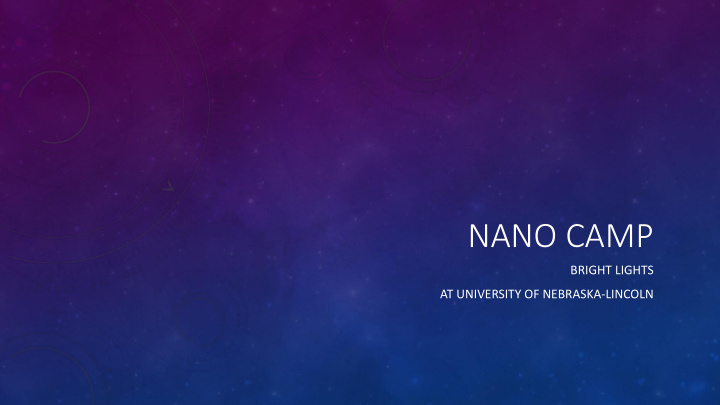



NANO CAMP BRIGHT LIGHTS AT UNIVERSITY OF NEBRASKA-LINCOLN
SNOWFLAKES - SELF-ASSEMBLY The complex structure of snowflakes results from the nanoscale arrangement of water molecules in an ice crystal.
WHY DO SNOWFLAKES HAVE 6 SIDES? Oxygen atoms self- assemble into a hexagonal shape through hydrogen bonds.
NOW YOU GET TO SELF-ASSEMBLE! • Look at your "Exploring Fabrication - Self Assembly" sheet - play Game 3 to build a human snowflake using the nanostructure model.
LOTUS LEAF - NANOFABRIC • Nanoscale features on surface influence how a material behaves on macroscale.
WHAT MAKES THINGS HYDROPHOBIC? • Surface of lotus leaves have waxy, nanometer-sized bumps that keep water and dirt from sticking. • Normally, water and dirty can attack a fabric from many angles, but adding a layer of hydrophobic solution covers fabric so that water and dirt collect on top of the 'whiskers' of the solution and roll off.
USE NANO FABRIC! • Look at your "Exploring Products - Nano Fabric" sheet - follow directions. • Demo - Nano Shirt with koolaid
SUNLIGHT - UV BEADS • UV beads contain special material (photocromic dye) that changes color when exposed to UV light because... the UV light breaks a bond in dye molecule so molecules rearranges shape. New shape needs more energy to have its bonds broken.
NANOSTRUCTURE - BUTTERFLY • Blue Morpho butterflies have wings with overlapping scales covered with ribs. There is air space a few nanometers between ribs so light waves bouncing off top and bottom surfaces of neighboring ribs interfere. • Spaces between gold particles cause different colors of gold.
Recommend
More recommend